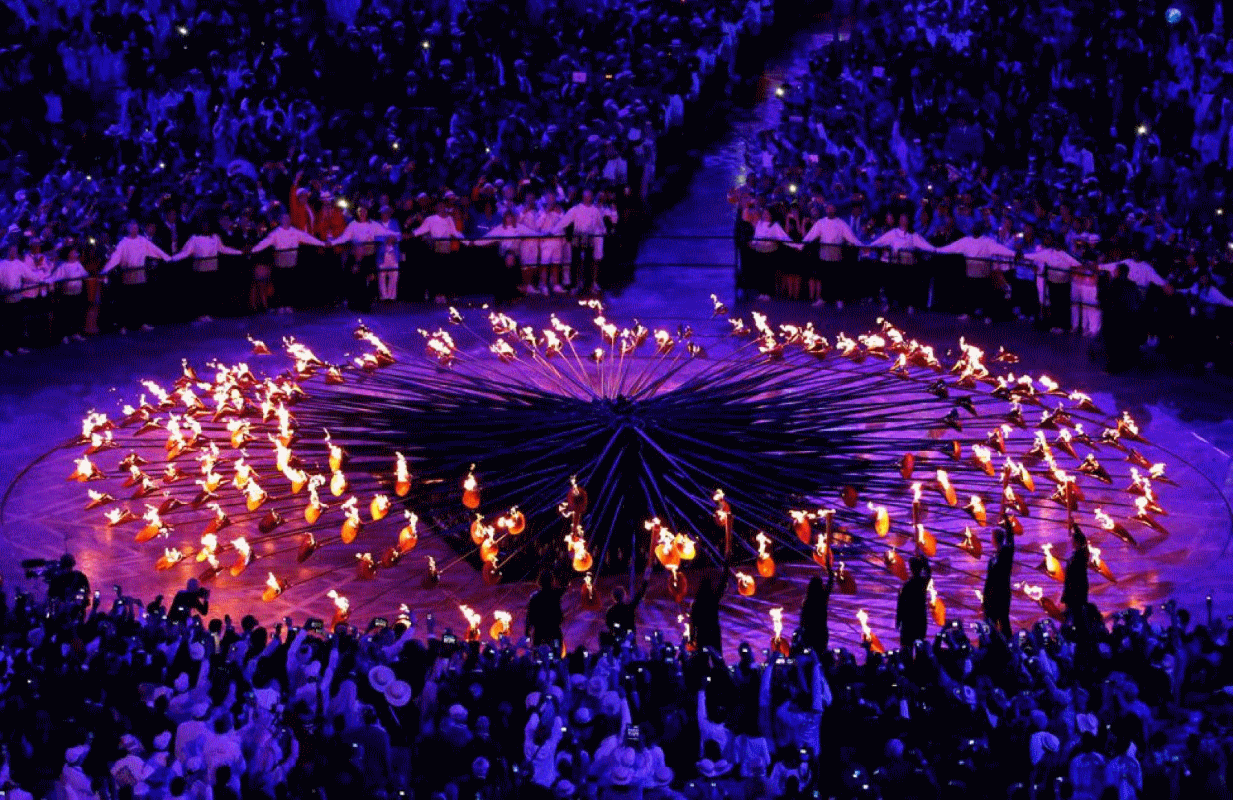Five Olympic Cauldron Lightings We'll Never Forget
-
 Clockwise from top: The lighting of the Olympic Cauldron in London 2012, Atlanta 1996, and Barcelona 1992.
Clockwise from top: The lighting of the Olympic Cauldron in London 2012, Atlanta 1996, and Barcelona 1992.Friday's opening ceremonies from Tokyo will mark the start of the most fraught Olympic games in modern memory. And while states of emergency, positive COVID cases and athlete withdrawals continue to happen, the hope is that once the opening ceremonies begin and the athletes take the stadium, viewers will remember what they love about the Olympics and fall into the rhythm of the games. One highlight of the opening ceremony is always the lighting of the Olympic cauldron, which has become as much a part of the over-the-top television production as anything else. Over the years Olympic host countries have opted for increasingly dazzling ways to light the cauldron that will burn through the two weeks of Olympic competition, with each country attempting to one-up the last. But a handful endure as the most eye-popping, soul-stirring, and memorable. Because it's the Olympics, we figured we'd rank them:
5. 1984 Los Angeles Olympics
The old-school option on this top five, the Los Angeles Olympics gets this distinction for capturing the grandeur of its location. The Los Angeles Coliseum is a grand, majestic stadium, and as the site for the track-and-field events in 1984, as well as the opening ceremonies, it was the centerpiece of the first summer Olympics held in the United States since 1932. To light the cauldron, Rafer Johnson, who had won the gold medal in the decathlon for the U.S. in 1960, ran a lap around the Coliseum's track, ascended the stadium's steps all the way to the top (which ought to be an Olympic event itself), then stood at the top of the stadium's archway and held the flame to a pipe, which shot the flame through the Olympic rings and up into the cauldron, a spectacular feat of athleticism and, well, fire. The only reason it's not a more spectacular moment is that it was held in daylight hours, robbing the fire's movement of some of its visual majesty.
4. 1996 Atlanta Olympics
The next time the summer games were held in the United States was perhaps the most emotionally affecting cauldron-lighting moment. Again the Americans chose to feature a former Olympic athlete, in this case, boxing legend Muhammad Ali, who won a gold medal at the 1960 games. By 1996, Ali was well into his diagnosis with Parkinson's disease, and the affects of the neurological condition were quite visible. Still, the legendary athlete took to the Olympic stadium with the torch in his hand, basking in the adulation of the Atlanta crowd, the picture of perseverance in the face of adversity. When Ali lit the wick on the ground, the flame shot up a wire, lighting the elaborately designed cauldron at the top of the stadium.
3. 2012 London Games

For reasons unknown to us, the International Olympic Committee won't let us embed video of the 2012 London Games cauldron lighting here, but you can view it on YouTube by following this link. Film director Danny Boyle produced the opening ceremonies, and it was a hugely intricate affair with moving scenery, dozens of performances, and a journey through England's history. He also had each country's athlete delegation accompanied by a horn-shaped metal "petal" that was placed at the center of the stadium. Once all the athletes were assembled, all 204 petals were all lit with the Olympic flame and then raised up together to form one cohesive inferno. The puzzle nature of this lighting was abstract at first, but the moment you realize how it's all coming together is a true stunner.
2. 2008 Beijing Games
In many ways, modern Olympic history can be divided between before the 2008 summer Olympics in Beijing and after. That's especially true when it comes to opening ceremonies. The pomp and pageantry of the pre-2008 ceremonies were blown out of the water by the large-scale extravaganza brought by film director Zhang Yimou, who produced the ceremony. When it came to lighting the Olympic flame, Chinese gymnast Li Ning was raised up on wires to the top of the famous Bird's Nest stadium, did a suspended "run" around the rim of the stadium as a scroll that was projected onto the stadium unfolded, and finally he lit the wick to the spiral flame to complete the theatrical, spectacular display.
1. 1992 Barcelona Games
Perhaps it's nostagia that's lead us to rank the relative simplicity of the Barcelona summer games cauldron lighting ahead of what is, objectively, the greater logistical and artistic triumph of Beijing. But there is something so starkly impressive about this moment, stripped of the production design of an expensive opening ceremony, where it was just archer Antonio Rebollo and his arrow lit aflame by the Olympic fire. Rebollo, from the field of the Olympic stadium, took his aim at the cauldron at the very top of the structure, fired his arrow straight and true, and dropped it right over the cauldron, where it lit the Olympic fire in spectacular fashion. Something about that moment, with one athlete, the world's attention on him, called upon to do what he excels at, when the pressure is on … and to succeed in a way that makes the whole world gasp in awe? That's the Olympics at their best.
NBC is airing this year's opening ceremonies live from Tokyo beginning at 6:55 AM ET/3:55 AM PT Friday, with a rebroadcast at 7:30 PM ET/4:30 PM PT.
People are talking about the 2020 Summer Games in our forums. Join the conversation.
Joe Reid is the senior writer at Primetimer and co-host of the This Had Oscar Buzz podcast. His work has appeared in Decider, NPR, HuffPost, The Atlantic, Slate, Polygon, Vanity Fair, Vulture, The A.V. Club and more.
TOPICS: Summer Olympics, NBC